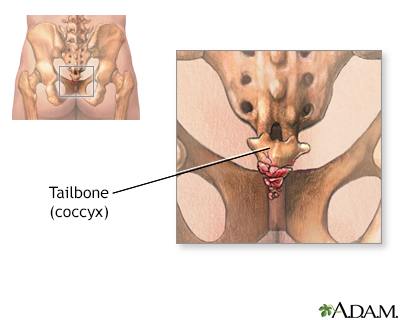Tailbone trauma
 Print-Friendly
Print-Friendly
Coccyx injury
Tailbone trauma is an injury to the small bone at the lower tip of the spine.
I Would Like to Learn About:
Considerations
Causes
Backward falls onto a hard surface, such as a slippery floor or ice, are the most common cause of this injury.
Symptoms
Symptoms include:
- Bruising on the lower part of the spine
- Pain when sitting or putting pressure on the tailbone
First Aid
For tailbone trauma when no spinal cord injury is suspected:
- Relieve pressure on the tailbone by sitting on an inflatable rubber ring or cushions.
- Take acetaminophen (Tylenol) or ibuprofen (Advil, Motrin IB) for pain.
- Take a stool softener to avoid constipation.
If you suspect injury to the neck or spine, DO NOT attempt to move the person.
Do Not
DO NOT attempt to move the person if you think there may be injury to the spinal cord.
When to Contact a Medical Professional
Call 911 or the local emergency number for immediate medical help if:
- Spinal cord injury is suspected
- The person can't move
- Pain is severe
Prevention
Keys to preventing tailbone trauma include:
- DO NOT run on slippery surfaces, such as around a swimming pool.
- Dress in shoes with good tread or slip-resistant soles, especially in snow or on ice.
Related Information
| Broken boneBleeding into the ... |
References
Bond MC, Abraham MK. Pelvic injuries. In: Walls RM ed. Rosen's Emergency Medicine: Concepts and Clinical Practice. 10th ed. Philadelphia, PA: Elsevier; 2023:chap 46.
Vora A, Chan S. Coccydynia. In: Frontera WR, Silver JK, Rizzo TD Jr, eds. Essentials of Physical Medicine and Rehabilitation: Musculoskeletal Disorders, Pain, and Rehabilitation. 4th ed. Philadelphia, PA: Elsevier; 2019:chap 99.





